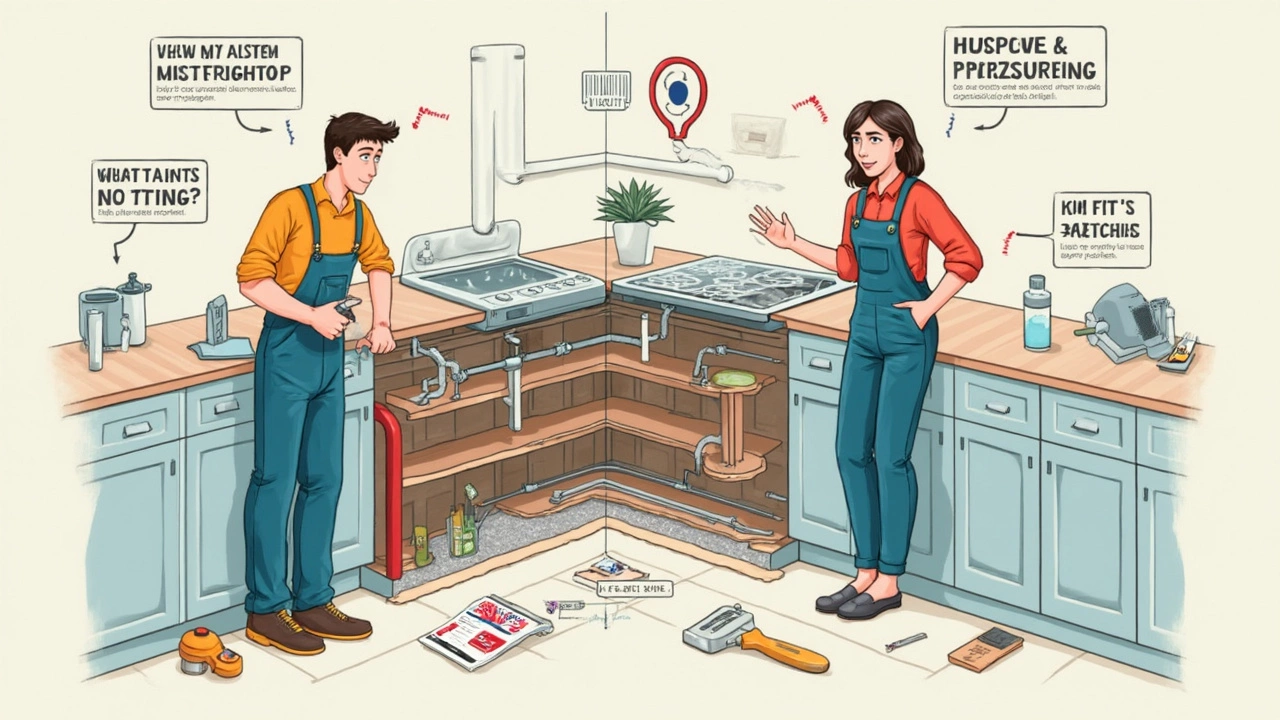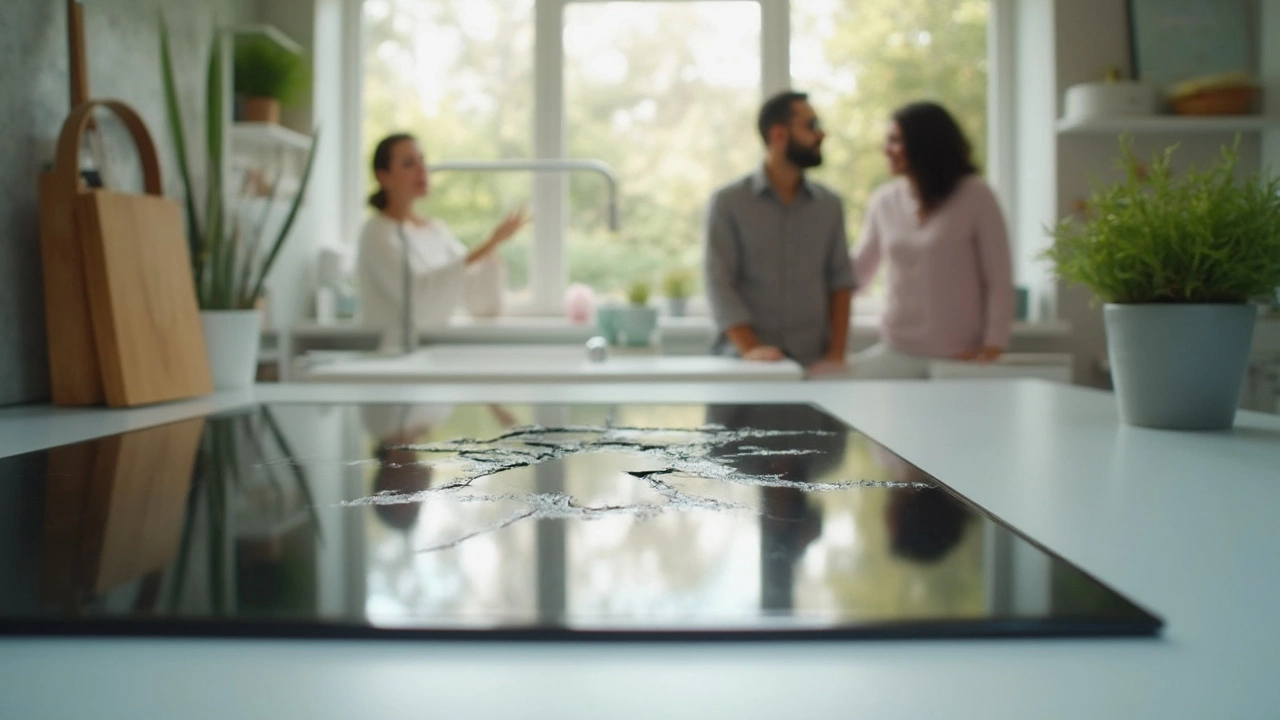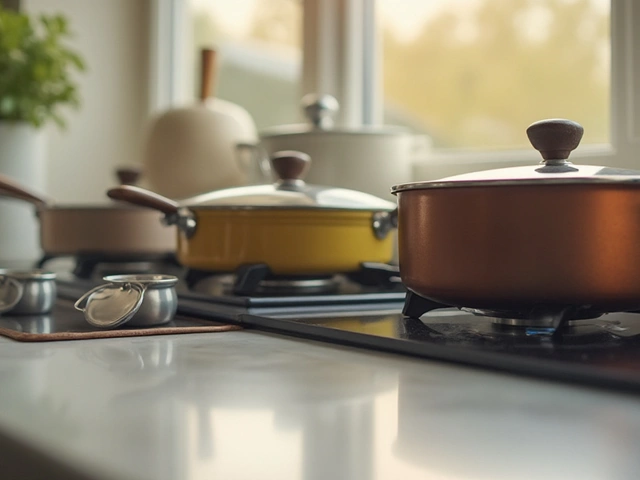Walk into your kitchen and see a crack slicing through your electric hob? That's a pain nobody wants. Believe it or not, electric hobs aren't made from some indestructible alien glass. They’re tough, but a mix of accidents and bad habits can wreck them faster than you'd think.
One of the main reasons electric hobs crack comes down to thermal shock. Imagine pouring cold water onto a sizzling hot glass stove — that sudden change in temperature can stress the material and cause it to crack right down the middle. Then there's the classic heavy pan slam, or worse, dropping a pan from a height. Even minor bumps add up over time.
Sometimes it’s not even your fault. A badly installed hob or poor-quality glass means cracks can sneak up out of nowhere, even if you’re super careful. The smallest invisible chip can grow quickly if ignored. Knowing these causes helps you dodge big repair bills and keep your kitchen running smoothly.
- What Makes an Electric Hob Crack?
- Daily Habits That Lead to Damage
- Spotting and Handling Small Cracks
- Can You Fix a Cracked Hob or Should You Replace It?
- Tips to Prevent the Next Crack
What Makes an Electric Hob Crack?
If you’ve noticed a crack in your electric hob, you’re not alone. It happens a lot more than people realize. But why does that smooth glass suddenly cave under pressure? The main reasons are physical impact, quick temperature changes, and issues with installation or the glass itself.
First up, there’s old-fashioned blunt force. Dropping a heavy saucepan or any hard object directly onto the surface is the fastest way to break your hob. Even a tiny chip that gets ignored can spread with time, especially if you keep cooking right on top of it.
Thermal shock is another big one. Imagine your hob surface is red-hot, then someone spills ice or pours cold water directly onto it. That extreme and sudden swing in temperature puts serious stress on the glass. It’s like your hob can’t handle the confusion and just snaps—sometimes literally.
Next, let’s not forget poor installation. If the hob isn’t fitted properly—maybe not sitting flush or the base isn’t supported evenly—cracks become much more likely. Sometimes the counters themselves are a bit off, or there’s a tiny gap underneath. Even the best glass in the world can’t hold up forever if it’s being bent the wrong way every time you use it.
Manufacturing defects are rare, but they do happen. Every now and then, a batch of glass isn’t tempered properly at the factory, which makes it more likely to crack even under normal use. Plus, cheap imports or knockoff parts can skip safety steps, leaving you with a ticking time bomb in your kitchen.
- Electric hob crack risk jumps most with sudden temperature changes and heavy impacts.
- Even older hobs that have seen years of use can become fragile over time, especially if tiny chips or scratches have worked their way in.
- Improper cleaning—like scrubbing with tough scouring pads—can scratch the glass and open it up to future cracks.
If you want the numbers, take a look at some common triggers and how often they show up:
| Cause | Estimated % of Cracks |
|---|---|
| Heavy Impact (e.g., dropped pan) | 45% |
| Thermal Shock | 30% |
| Poor Installation | 15% |
| Manufacturing Defect | 5% |
| Other (e.g., misuse, cleaning damage) | 5% |
In short, a crack can sneak up on you from more angles than you’d think. Most are caused by honest mistakes or just everyday wear and tear. Keeping an eye out for those usual suspects can make the difference between years of smooth cooking—or a sudden, expensive repair.
Daily Habits That Lead to Damage
A lot of people don’t realize how simple everyday moves can make an electric hob crack. It’s not just big accidents; small habits grow into big problems.
Let’s break down the stuff most folks do without thinking:
- Slamming Pots and Pans: Putting down heavy cookware too hard on the glass surface is like asking for trouble. Even setting down a hot pan too quickly can chip or fracture the hob over time.
- Boiling Over and Spills: Letting water or food boil over causes sudden temperature shifts, which can stress the glass. Sticky spills that get burnt in are even worse—scraping them can scratch or weaken the hob.
- Using the Hob as Extra Counter Space: Using the hob as a storage zone for groceries, bags, or other kitchen stuff puts weird pressure points on the glass. Even closed packets or jars can crack the surface if dropped or pushed.
- Dragging Cookware: Sliding pans around can slowly scratch the hob, which might not look serious at first. But scratches are weak points where cracks love to start.
- Cold Water on Hot Hob: Cleaning the hob right after cooking by splashing cold water? That temperature shock can be enough to split the glass.
Here’s a quick rundown of how often these habits cause problems, based on appliance repair data:
| Habit | Percentage of Reported Hob Cracks |
|---|---|
| Slamming pots/pans | 38% |
| Boil-overs/spills | 19% |
| Using as storage space | 14% |
| Dragging cookware | 9% |
| Cold water on hot hob | 20% |
This stuff adds up, even when it doesn’t seem like a big deal at the time. If you want your hob to last, making tiny tweaks in how you use it can make a huge difference. Don’t set your pan down too hard, wipe up spills quickly (but not with cold water!), and stop stacking bags or pots on the stove when you’re not actually cooking.

Spotting and Handling Small Cracks
It’s easy to miss tiny cracks on your electric hob, especially when you're in the middle of cooking. But even the smallest crack can get worse pretty fast if you ignore it. Start by running your fingers (gently, so you don’t cut yourself) over suspect areas. Keep an eye out for thin lines, splinters, or cloudy patches that don’t wipe away.
If you spot a new crack, don’t panic. First, unplug the appliance or switch it off at the wall. This stops any risk with electricity and lets you look safely. The next step? Figure out if the crack is just on the surface or goes deeper. Surface cracks feel like a scratch or a hairline mark, but deeper ones might catch your nail or feel uneven. Most surface cracks won’t leak electricity, but once a crack cuts through the glass, you’re risking safety and performance.
- A crack shorter than 2 cm that doesn’t feel deep often just needs to be monitored.
- If it grows, stop using that burner.
- Superficial chips or small lines can sometimes be sealed temporarily with a clear, heat-resistant epoxy — but don’t treat this as a fix for the long term.
- Deeper or spreading cracks mean the hob should be switched off and checked by a technician.
Here’s a quick table so you know what to watch for:
| Crack Type | What To Do | Risk Level |
|---|---|---|
| Surface scratch (under 2 cm) | Monitor, use with care | Low |
| Deep crack (over 2 cm, catches nail) | Stop using, call repair | High |
| Spider-web crack | Stop using, replace glass | Very High |
| Chips near control panel | Monitor, check buttons | Medium |
One more tip: Clean the hob regularly, since spills hide the early signs of damage. Smudges and grease make cracks nearly invisible. A clean hob lets you spot trouble early and avoid a full-on electric hob crack disaster before it starts.
Can You Fix a Cracked Hob or Should You Replace It?
It’s tempting to hope a cracked hob is a quick fix, but most times you’re facing two real choices: live with it (not recommended if the damage is bad), or replace it. Here's the truth—if the crack is small and only on the surface, some people try temporary fixes. These include heat-resistant epoxy or using special glass repair kits. But be clear: these patches are only quick Band-Aids. They won’t bring your electric hob back to full strength or safety.
Cracks can mess with how heat spreads, which isn’t just annoying—it can be dangerous. Big cracks or any damage near the controls mean you should stop using the hob right away. And if the crack is making the top uneven, pans can tip, which is a whole new headache.
Major brands and repair pros agree: if the damage runs deep, goes across the cooking zone, or you can feel it with your fingernail, you’re safer replacing the glass top. Repairs for electric hobs with real structural cracks almost always cost nearly as much as a new top—and can leave you worrying every time you turn it on.
Check the table for a quick comparison of options and costs in the UK:
| Option | Average Cost (GBP) | Safety Level |
|---|---|---|
| DIY Epoxy Patch | £10-£20 | Low (temporary only) |
| Professional Glass Top Replacement | £120-£250 | High |
| Full Hob Replacement | £220-£500+ | High |
If your hob is still under warranty, check with the shop or manufacturer before you do anything. Hobs covered under warranty might get repaired or replaced at no cost, especially if electric hob crack wasn’t your fault.
At the end of the day, safety has to come first. Even minor cracks can get worse with daily use, letting in moisture or causing electrical faults. If you’re in doubt or the crack is getting bigger, replacement is your best bet for peace of mind—and safe cooking.

Tips to Prevent the Next Crack
Why keep paying for repairs if you can just avoid cracks in the first place? It comes down to a handful of smart habits. Let’s go through what actually works—with some science to back it up.
- Don’t slam pans or heavy pots down. It sounds obvious, but this is the number one cause of a broken or chipped surface. Glass experts at Schott AG (the folks who supply a lot of cooktop glass) say,
“Mechanical impacts—even small ones—can weaken the toughened glass, causing cracks to appear later.”
- Watch out for sudden temperature changes. Never pour cold water or put a frozen pack onto a hot hob. The fast cooling and heating actually cause the glass to contract or expand too quickly, leading to that dreaded crack.
- Only use cookware with a flat, smooth base. Wobbly pots scrape the surface and cause stress points. Also, if your cookware is bigger than the heating zone, it can push heat to the edges and risk a crack near the border.
- Keep an eye on spills, especially sugary ones. Burned sugar can stick and, when you scrape it off, you might chip the surface. Always let the hob cool down first and use a proper scraper or cleaner designed for glass hobs.
- Check your installation. A poorly fitted hob—even by half a millimeter—can put pressure on the glass. If you have any doubts, grab a level and check the countertop; a warped surface means trouble down the road.
If you’re thinking long-term, consider picking up a hob top protector mat (the silicone kind, not metal). They’re cheap, easy to wipe, and actually absorb small impacts. Just remember to remove them when the hob is hot and in use.
By following these tips, you dodge most reasons an electric hob crack shows up and keep your kitchen worry-free.




